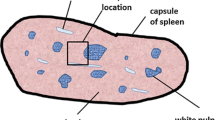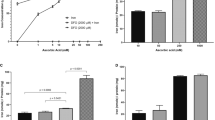Summary
A short exposure of cell suspensions to gaseous hydrogen sulfide, appropriate fixations, and subsequent physical development of silver shells around sulfidated insoluble metals were used to amplify ferritin iron cores in blood and bone marrow cells. The methods described are suitable for both light microscopy and transmission electron microscopy. These techniques made it possible to visualize Prussian Blue stainable ferritin and haemosiderin, as well as a large variety of isoferritin iron and other smaller particles beyond the sensitivity of Prussian Blue staining. Admixtures of sulfidatible zinc and traces of other heavy metals had to be taken into consideration. For further research, adaptations of sulfide silver staining to microphysical analyses were developed. However, conventional energy dispersive X-ray analysis was not sensitive enough to signalize the presence of Fe in sulfide silver amplified iron cores of a single or a few ferritin molecule(s). Proton-induced X-ray emission was used to measure Fe and Zn down to 1 fg/single cell in unstained or sulfide silver stained smears on thin foils. However, multielement analysis of homogeneous cell concentrates was much easier to perform and far more sensitive. In advanced iron overload, highly increased sulfide silver staining was found in peripheral blood cells including lymphocytes, monocytes, eosinophils, basophils, and — in extreme cases — also in neutrophils and platelets.
Similar content being viewed by others
References
Danscher G (1981) Histochemical demonstration of heavy metals. A revised version of the sulphide silver method suitable for both light and electron microscopy. Histochemistry 71: 1–16
Danscher G (1984) Autometallography. A new technique for light and electron microscopic visualization of metals in biological tissues (gold, silver, metal sulphides and metal selenides). Histochemistry 81: 331–335
Harrison PM, Clegg GA, May K (1980) Ferritin structure and functions. In: Jacobs A, Worwood M (eds) Iron in biochemistry and medicine II. Academic Press, London New York, pp 131–171
Hartmann HJ, Weser U (1984) A structure and function correlation of metalthiolate proteins. In: Brätter P, Schramel P (eds) Trace element analytical chemistry in medicine and biology. Walter de Gruyter, Berlin New York, pp 267–281
Weser U (1986) Personal communication
Hausmann K, Neth R (1960) Zur Lokalisation und Bedeutung der Schwermetalle in Blutzellen. Verh Dtsch Ges Inn Med 66: 1069–1070
Hausmann K (1963) Der zytochemische Nachweis des Nicht-Hämoglobineisens mit Hilfe der Sulfidsilbermethode. In: Merker H (ed) Zytochemie und Histochemie in der Hämatologie. Springer, Berlin Heidelberg New York, pp 582–586
Heilmeyer L (1963) Discussion p 590 to 6a
Hausmann K (1963) Cytochemical demonstration of heavy metals in leucocytes and their precursors. Proceedings of the 9th Congr European Society of Haematology, vol II/1. S Karger, Basel New York, pp 133–136
Hausmann K (1967) Lokalisation und zytochemische Differenzierung locker gebundener Schwermetalle in Blut- und Knochenmarkzellen. Proceedings of the 10th Congress of the European Society of Haematology, part II. S Karger, Basel New York, pp 80–84
Hausmann K (1970) Zytochemie des Nicht-Hämoglobineisens der Erythrozyten nach Splenektomie und bei Milzinsuffizienz. In: Lennert K, Harms D (eds) Die Milz/The spleen. Springer, Berlin Heidelberg New York, pp 211–218
Hausmann K, Kuse R (1970) Morphological types of nonhaeme iron in bone marrow squash preparations and intestinal iron absorption. In: Hallberg L, Harwerth HG, Vanotti A (eds) Iron deficiency. Pathogenesis, clinical aspects, therapy. Academic Press, London New York, pp 297–306
Hausmann K, Wulfhekel U, Düllmann J, Kuse R (1976) Iron storage in macrophages and endothelial cells. Histochemistry, ultrastructure, and clinical significance. Blut 32: 289–295
Jacobs A, Hodgetts J, Hoy TG (1984) Functional aspects of isoferritins. In: Albertini A, Arosio P, Chiancone E (eds) Ferritins and isoferritins as biochemical markers. Elsevier Science Publishers, Amsterdam New York Oxford, pp 113–127
James TH (1977) Theory of the photographic process. 4th Edn. McMillan, New York London, pp 373–403
Neth R, Beckmann H, Maas B, Schäfer KH (1966) Die Bedeutung cytochemischer und mikrochemischer Eisenstoff-wechseluntersuchungen. Klin Wochenschr 44: 687–695
Pihl E (1967) Ultrastructural localization of heavy metals by a modified sulfide-silver method. Histochemie 10: 126–139
Pihl E, Gustafson GT, Josefson B, Paul KG (1967) Heavy metals in the granules of eosinophilic granulocytes. Scand J Haematol 4: 371–379
Pihl E, Gustafson GT (1967) Heavy metals in rat mast cell granules. Laboratory Investigation 17: 588–598
Saab G, Green R, Jurgus A, Sarrou E (1986) Monocyte ferritin in idiopathic haemochromatosis, thalassaemia, and liver disease. Scand J Haematol 36: 65–70
Shuman H, Somlyo AP (1976) Electron probe X-ray analysis of single ferritin molecules. Proc Natl Acad Sci USA 73: 1193–1195
Steidle CH, Huhn D (1974) Elektronenmikroskopische Untersuchungen zur Phagocytose von Blutlymphozyten. Res Exp Med 163: 155–162
Sumner AT (1983) X-ray microanalysis: A histochemical tool for elemental analysis. Histochem J 15: 501–541
Timm F (1958) Zur Histochemie der Schwermetalle. Das Sulfid-Silber-Verfahren. Dtsch Z Gerichtl Med 46: 706–711
Vis RD (1985) The proton microprobe: Applications in the biomedical field. CRC Press Inc., Boca Raton, Florida
Vogt H, Heinen HJ, Meier S, Wechsung R (1981) LAMMA 500 Principle and technical description of the instrument. Fresenius Z Anal Chem 308: 195–200
Wagstaff M, Worwood M, Jacobs A (1980) Biochemical and immunological characterization of ferritin from leukaemic cells. Br J Haematol 45: 263–274
Webb J, Kim KS, Talbot V, Macey DJ, Mann S, Bannister JV, Williams RJP, StPierre TG, Dickson DPE, Frankel R (1986) Comparative chemical and biological studies of invertebrate ferritins. In: Xavier AV (ed) Frontiers in bioinorganic chemistry. UCH Verlag, Weinheim, pp 287–299
Yam LT, Finkel HE, Weintraub LR, Crosby WH (1968) Circulating iron containing macrophages in haemochromatosis. N Engl J Med 279: 512–514
Author information
Authors and Affiliations
Rights and permissions
About this article
Cite this article
Hausmann, K., Wedekind, I., Tenner-Racz, K. et al. Sulfide silver amplification of ferritin iron cores in blood and bone marrow cells. Blut 56, 221–227 (1988). https://doi.org/10.1007/BF00320109
Received:
Accepted:
Issue Date:
DOI: https://doi.org/10.1007/BF00320109




